Related Research Articles

James Ewell Brown "Jeb" Stuart was a United States Army officer from Virginia who became a Confederate States Army general during the American Civil War. He was known to his friends as "Jeb,” from the initials of his given names. Stuart was a cavalry commander known for his mastery of reconnaissance and the use of cavalry in support of offensive operations. While he cultivated a cavalier image, his serious work made him the trusted eyes and ears of Robert E. Lee's army and inspired Southern morale.

George Armstrong Custer was a United States Army officer and cavalry commander in the American Civil War and the American Indian Wars.

George Edward Pickett was a career United States Army officer who became a major general in the Confederate States Army during the American Civil War. He is best remembered for being one of the commanders at Pickett's Charge, the futile and bloody Confederate offensive on the third day of the Battle of Gettysburg that bears his name.
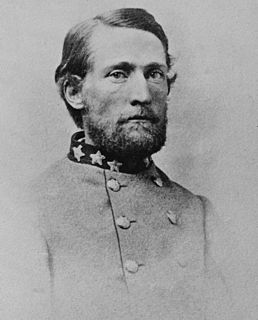
John Singleton Mosby, also known by his nickname, the "Gray Ghost", was a Confederate army cavalry battalion commander in the American Civil War. His command, the 43rd Battalion, Virginia Cavalry, known as Mosby's Rangers or Mosby's Raiders, was a partisan ranger unit noted for its lightning-quick raids and its ability to elude Union Army pursuers and disappear, blending in with local farmers and townsmen. The area of northern central Virginia in which Mosby operated with impunity became known as Mosby's Confederacy. After the war, Mosby became a Republican and worked as an attorney, supporting his former enemy's commander, U.S. President Ulysses S. Grant. He also served as the American consul to Hong Kong and in the U.S. Department of Justice.
The Michigan Brigade, sometimes called the Wolverines, the Michigan Cavalry Brigade or Custer's Brigade, was a brigade of cavalry in the volunteer Union Army during the latter half of the American Civil War. Composed primarily of the 1st Michigan Cavalry, 5th Michigan Cavalry, 6th Michigan Cavalry and 7th Michigan Cavalry, the Michigan Brigade fought in every major campaign of the Army of the Potomac from the Battle of Gettysburg in July 1863 to the Confederate surrender at Appomattox Court House in April 1865.
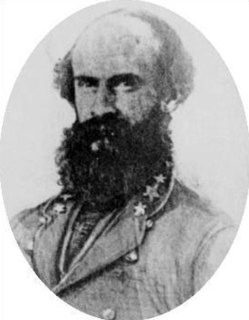
William Edmondson "Grumble" Jones was a Confederate cavalry general with a reputation for being a martinet to his troopers and fractious toward superiors, but acknowledged to be a good commander. After disagreements of a personal nature with J.E.B. Stuart, Jones's brigade was set to guarding supply lines and unavailable during a crucial juncture of the Gettysburg Campaign when Lee suffered from a lack of capable reconnaissance cavalry. As the personality clash between Jones and Stuart escalated, Jones faced charges for impertinence, and was transferred to separate him from Stuart. Jones was killed leading a counter-attack in the 1864 Battle of Piedmont.
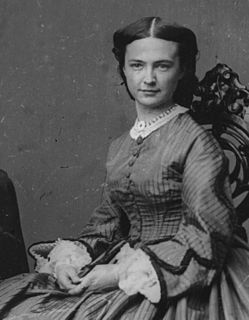
Elizabeth Bacon Custer was an American author and public speaker, and the wife of Brevet Major General George Armstrong Custer, United States Army. She spent most of their marriage in relative proximity to him despite his numerous military campaigns in the American Civil War and subsequent postings on the Great Plains as a commanding officer in the United States Cavalry.
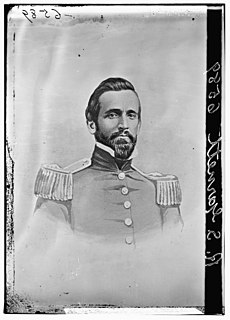
Richard Brooke Garnett was a career United States Army officer and a Confederate general in the American Civil War. He was court-martialed by Stonewall Jackson for his actions in command of the Stonewall Brigade at the First Battle of Kernstown, and killed during Pickett's Charge at the Battle of Gettysburg.

James Lawson Kemper was a lawyer, a Confederate general in the American Civil War, and the 37th Governor of Virginia. He was the youngest brigade commander and only non-professional military officer in the division that led Pickett's Charge, during which he was severely wounded.

Elon John Farnsworth was a Union Army captain in the American Civil War. He commanded Brigade 1, Division 3 of the Cavalry Corps from June 28, 1863 to July 3, 1863, when he was mortally wounded and died at the Battle of Gettysburg. He was nominated by President Abraham Lincoln for appointment to the grade of brigadier general on June 29, 1863 but was not confirmed by the United States Senate before his death at Gettysburg.

On the third day of the Battle of Gettysburg during the disastrous infantry assault nicknamed Pickett's Charge, there were two cavalry battles: one approximately three miles (5 km) to the east, in the area known today as East Cavalry Field, the other southwest of the [Big] Round Top mountain.
The Philadelphia Brigade was a Union Army brigade that served in the American Civil War. It was raised primarily in the city of Philadelphia, Pennsylvania, with the exception of the 106th regiment which contained men from Lycoming and Bradford counties.
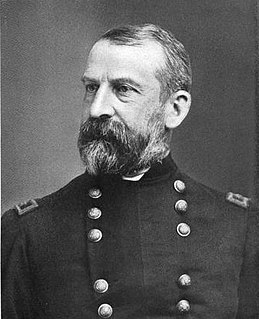
William W. Wells, Jr. was a businessman, politician, and general in the Union Army during the American Civil War who received a Medal of Honor for gallantry at the Battle of Gettysburg.

Edwin Henry Stoughton was appointed a brigadier general in the Union Army during the American Civil War, but his appointment expired after it was not confirmed by the U.S. Senate. Four days later, on March 8, 1863, he was captured by Confederate partisan ranger John S. Mosby while asleep at his headquarters in the Virginia village of Fairfax Court House. The incident became well known, and Stoughton became an object of ridicule as a result. He was included in a prisoner exchange two months later but resigned his commission after he was not reappointed as a brigadier general.

The 1st West Virginia Cavalry Regiment served in the Union Army during the American Civil War. Although it started slowly, it became one of the most active and effective of the West Virginia Civil War regiments—and had 14 Medal of Honor recipients, the most for any West Virginia regiment during the war. It was originally called the 1st Virginia Cavalry, not to be confused with the Confederate 1st Virginia Cavalry. Some reports added "Union," "Loyal" or "West" when identifying this regiment. After the Unionist state of West Virginia was officially admitted to the Union in 1863, the regiment became the 1st West Virginia Cavalry Regiment. The National Park Service identifies it as the 1st Regiment, West Virginia Cavalry.
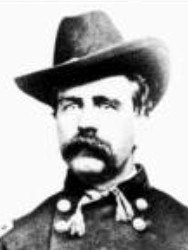
Henry Capehart was a surgeon and officer in the U.S. Cavalry during the American Civil War. He received the Medal of Honor for saving the life of a drowning soldier while under fire at Greenbrier River, West Virginia, on May 22, 1864.

The Battle of Fairfax Court House was fought during the Gettysburg Campaign of the American Civil War between two cavalry detachments from the Union Army of the Potomac, commanded by General Joseph Hooker, and the Confederate Army of Northern Virginia, commanded by General Robert E. Lee.

The 202nd Regiment Pennsylvania Volunteer Infantry was an infantry regiment of the Union Army in the American Civil War. Raised in the Harrisburg area and the Coal Region in August and September 1864, the regiment was sent to the Manassas Gap Railroad to guard it against the attacks of Confederate partisan rangers led by John Mosby. Following the Union victory at Battle of Cedar Creek, the regiment helped break up the now unneeded railroad and moved to Alexandria to guard the railroad there. After the end of the war, the regiment served in the Coal Region to suppress labor unrest, and was mustered out in mid-1865.

The Warrenton Junction Raid was a surprise attack by Confederate guerrilla warriors on a Union cavalry detachment during the American Civil War. The raid took place near a railroad junction in Virginia's Fauquier County, less than 10 miles (16 km) from the town of Warrenton. Confederate Major John S. Mosby led the attack against about 100 men from the Union's 1st (West) Virginia Cavalry. At first, the raid was very successful, as many of the Union soldiers surrendered to the rebels. The remaining portion of the surprised force was surrounded in a house, and two of their leaders were wounded. The house was set on fire, and the Union soldiers surrendered. As Mosby's men rounded up prisoners and horses, a detachment of the 5th New York Cavalry surprised the rebels and rescued most of the captured Union soldiers. After a short fight, more men from the 5th New York, and the 1st Vermont Cavalry, joined in the pursuit of Mosby's fleeing rebels.

The 18th Pennsylvania Cavalry Regiment was a cavalry regiment of the Union Army during the American Civil War. The regiment was present for 50 battles, beginning with the Battle of Hanover in Pennsylvania on June 30, 1863, and ending with a skirmish at Rude's Hill in Virginia during March 1865. A majority of its fighting was in Virginia, although its first major battle was in Pennsylvania's Gettysburg campaign. It was consolidated with the 22nd Pennsylvania Cavalry Regiment on June 24, 1865, to form the 3rd Provisional Pennsylvania Cavalry Regiment.
References
- ↑ "Jeffry D. Wert". Archived from the original on 2013-05-15. Retrieved 2012-06-08.
- ↑ Duncan, Richard R. (1992). "Reviewed Work(s): Mosby's Rangers by Jeffry D. Wert". The Journal of Southern History . 58 (2): 357–358. doi:10.2307/2210891. JSTOR 2210891.
- ↑ DeBlack, Thomas A. (1997). "Reviewed Work(s): Custer: The Controversial Life of George Armstrong Custer by Jeffry D. Wert". The Arkansas Historical Quarterly . 6 (1): 114–116. doi:10.2307/40031012. JSTOR 40031012.
Wert's account of Custer's life and career is a well-written and thoroughly researched narrative, utilizing much recent scholarship and archival material.